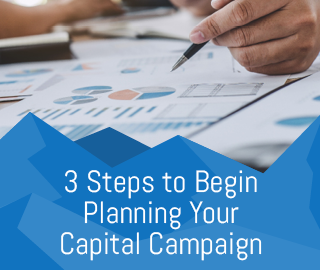Capital campaigns are intensive, game-changing undertakings for nonprofit organizations. These major campaigns raise significant amounts of funding for specific expansion projects, like constructing new facilities, investing in new equipment, or creating an endowment fund. As major investments in your organization’s ability to grow, these campaigns require tons of strategic planning to be pulled off successfully.
At the Capital Campaign Toolkit, we believe that planning is doing. Simply put, this means that the early planning stage of your campaign should accomplish more than just outlining the steps you’ll follow later. Instead, effective capital campaign planning should be a more active process, one that begins engaging the board members and key donors who’ll be integral to your overall success.

Let’s discuss three steps you can take now—before outlining specific fundraising tasks, writing letters to donors, or diving into the world of virtual galas—to give your capital campaign a strong footing from the get-go.
The first three steps you should take when planning your campaign are:
- Clearly define your campaign’s purpose.
- Plan with a focus on your top donors from the start.
- Actively speak with your key donors.
We’ve helped equip countless nonprofit development teams with all of the tools and support they need to conduct a successful capital campaign, and we’ve found that one of the best ways to set up any campaign for success is to make the most of the planning process. Let’s dive in.
1. Clearly define your campaign’s purpose.
Capital campaigns aren’t dreamt up in a day. They’re massive fundraising efforts that go above and beyond any other campaign, far surpassing your annual fund in dollars raised.
Capital campaigns are driven by a very specific need or project that require an infusion of resources to build capacity. The identification of those needs often grows out of a strategic or long-range plan that spells out what it will take for the organization to reach the next level of operation.
This means that the first step in planning your capital campaign should be to specifically define what you’re raising funds for. To convince people to rally behind your organization and give generous contributions, you must clearly articulate why you’re seeking their support and what difference their support will make. The purpose of a capital campaign will be composed of two parts:
- Objective: This is what you’re raising funds for. So, for a nonprofit organization that provides after-school programming for students, this might be constructing a new gym or art room.
- Goal: This is the specific financial amount you need to raise in order to complete your objective, like raising $10 million to construct the new gym.
When setting this goal, work with your board from the start. This early collaboration serves two purposes:
- It builds excitement across your board and obtains their buy-in to the process, getting them invested in the campaign and ready to contribute when the time comes.
- It gives you additional perspectives to consider, allowing you to set an objective and goal that’s informed by your board’s knowledge of your nonprofit and current fundraising capacity.
Of course, your board will need to approve any major fundraising efforts and campaign spending anyway, so don’t overlook this step. Take this first task a step further by asking your board to assist with crafting your case for support or case statement—a document that clearly communicates why you’re raising funds, how you’re going to use those funds to meet your objective, and why prospective donors should give.
When developing a case statement, we recommend conducting a “Features and Benefits” exercise with your board to discover the features of your campaign (what your campaign will fund) and the benefits of each feature. For example, a soup kitchen raising funds to build a new eating hall would list their new building as a key feature of their campaign. Its benefits would be the many more constituents that the organization would be able to feed.
Working with your board members in the early planning phase of your campaign will build the trust you will need for them to approve the campaign. So be sure to give them an active hand in shaping your campaign and laying the groundwork for a powerful case for support. Here are some tips to help you improve communications with your board.
2. Plan with a focus on your top donors from the start.
Once you’ve identified what you want to accomplish with your campaign—your objective and working goal—then you can begin planning with a focus on your top donors.
Capital campaigns are top-heavy by nature. You should plan to raise at least half of your total campaign gifts from the top 10 donations during the initial quiet phase of your campaign. Keep this in mind from the start of your campaign and begin identifying who those key donors are once your plans start taking shape.
The standard way to keep your efforts donor-centric is to anchor your plan with a gift range chart. This guiding document will be an invaluable resource throughout the entire duration of your campaign. When examining prospects in your donor database and beyond to identify potential contributors, consider the following:
- Who has the financial capacity to make multi-thousand to million-dollar gifts?
- Who has a strong existing relationship with your organization and cause?
Focus the majority of your cultivation and solicitation efforts on donors with this winning combination of capacity and inclination to give.
A quick tip to make sure you’re planning with a spotlight on these critical supporters: Block out at least two hours per week during your campaign to personally meet with or talk with major donor prospects.
This doesn’t mean that you’re going to solicit gifts each week but rather that you’ll plan from the start to intentionally focus on building relationships with your top donors. That will generate buy-in from prospects and strengthen their attachment to your cause. Successfully soliciting a large gift takes time and persistence.
3. Actively speak with your key donors.
You’ve planned to meet with prospects for at least two hours each week—excellent! Begin these conversations with your key donors by interviewing them as part of your feasibility study.
A feasibility study is an important early step in any capital campaign, and it involves discussing your plans with key stakeholders to gauge their thoughts on your goals and interest in potentially giving. If feasibility studies are a new concept for your organization, check out our complete guide for an overview.
An effective feasibility study will aim to answer a few key questions. Do your key stakeholders and prospects believe your nonprofit is prepared for a campaign of this magnitude? Do they have advice that you can use to drive your campaign to success? These answers will be extremely useful for shaping your strategies as your campaign plans come into sharper focus.
If you’ve encountered feasibility studies before, you might think that nonprofits should only ever bring in third-party consultants to conduct them. However, we encourage you to consider speaking with your key donors yourself.
Remember, planning is doing. While a feasibility study is seen as part of the broader planning phase of your campaign, these conversations are invaluable opportunities for you to begin actively building relationships with the donors who could potentially make or break your success. Don’t wait to start building and strengthening those relationships!
Ask your prospects and stakeholders overarching questions about what they think of your organization, leadership, and case for support. This will give you insight into your campaign’s feasibility, as well as signal to the donor that you value their views. You may find that they believe that you’re well prepared, or you may find that they believe you need to hit the books to better prepare for the endeavor. Either way, seeking their advice will let them know that you respect and value their perspectives.
After you’ve already introduced your campaign and gauged their interest, take this opportunity to begin directly asking prospects about potential involvement. Try questions like:
- Among your philanthropic priorities, where is our organization?
- Do you see yourself making a gift to the campaign when the time is right?
- Would you consider volunteering for the campaign?
With these questions, you can better understand your prospects’ expectations of your campaign and their involvement in it. These insights will immediately benefit your cultivation efforts, helping you quickly get a sense of where to focus attention. You may even secure early gift commitments from your most dedicated supporters!
Feasibility studies are a critical part of any capital campaign, but don’t assume that the entire process will have to be completely out of your hands. These interviews and discussions are your first major chance to begin developing the relationships that will drive your campaign to success, so take an active approach. There are resources available (such as our Guided Feasibility Study) to help your team select donors, train to conduct the interviews, and prepare reports for your board.
Planning a capital campaign is a months-long process. After all, you’re raising more funds than your nonprofit likely ever has before and mapping out years of stewardship and fundraising strategies to reach what is often a multi-million-dollar goal.
However, you don’t have to wait until the planning process is complete to begin acting on those plans. By taking an active, intentional approach and collaborating with key stakeholders early, you can begin building valuable relationships that will fuel your campaign down the line. Wishing you a hugely successful campaign!
About the Author: Andrea Kihlstedt

Andrea Kihlstedt, Campaign Expert & Co-Founder, is the author of Capital Campaigns: Strategies that Work, now in its 4th edition, as well as How to Raise $1 Million (or More) in 10 Bite Sized Steps, in addition to several other fundraising books. She has been leading successful capital campaigns for over 30 years.